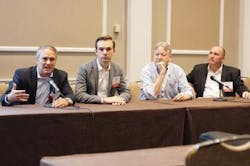“IoT and the Brave New Connected World” included Calum Barnes, the Xively Product Owner at LogMeIn; Steve Jennis, Senior Vice President for Corporate Development at PrismTech; Dan Potter, Vice President, Product Marketing at Datawatch; and Howard Heppelmann - Divisional VP and General Manager, Connected Product Management Segment at PTC. (Biographies)
Howard Heppelmann, PTC, shares his thoughts at the IIC panel discussion. Other panelists, left to right: Calum Barnes, LogMeIn; Steve Jennis, PrismTech; Dan Potter, Datawatch.
Among the most interesting observations:
CALUM: I think we are seeing [IoT] adoption in the high ROI use cases. People want to be feature-enabled but where we see opportunity is in how to reduce service burdens. So, we will get to the connected coffee maker but you need to wait for the cost to go lower. It isn’t $250 connected thermostats.
...We see a lot of customers hearing that the data they are generating is an asset that you must collect and act upon. We say if you don’t know what the data is, it isn’t an asset it is a liability. You don’t know how to sort and store it so it opens you up to hackers. We recommend thinking about the problems you have and using data and tools to address those first.
JENNIS: A skills shortage is the key to Gartner [IoT] forecasts. Think of system integration channels, even on a systems level management of integration, we won’t solve that with humans. It has to be technology embedded in the things and in fault nodes and gateways and analytics. We have to fix that problem. It is not accidental that that end of the market has been dominated by smaller companies, technical solutions and a lot of customer code. When you see big players like Cisco and Microsoft entering the space, they will want to come with more complete solutions, appliances and applications, and analytics.
POTTER: In the manufacturing space we have seen great interest in this [IIoT]. The value in many industries is around real-time. That is a barrier. In the oil and gas industry, you have existing infrastructure with sensor data but organizations haven’t been able to tap into that for production surveillance. There are now interfaces opening up that data in meaningful ways to allow oil and gas producers to move from overnight batch collection to real-time. In one of our customers they talked about spending $100 million a year for steam generation used in fracking. They used to decide once a day what their steam production should be. Real-time data is saving them 3-5 percent, or $3 to $5 million a year.
HEPPELMANN: I think we haven’t seen the contribution of IoT come into play yet; we see people just out retrofitting things. We are expecting the next generation will be going to the factory and on to the roads prepared for IoT. So, if you are looking for IoT to play out in the next 12 months you will be disillusioned. However, manufacturers used to ask, “Should we connect our products?” No one wonders about that any more. Companies are changing their organizations and product development and there is value to be harvested right now.
Alan R. Earls is a Boston-based writer focused on technology, business, and manufacturing — a field where he spent the earliest part of his career. He has written for publications and websites as diverse as The Boston Globe, Computerworld and Modern Infrastructure as well as Industry, The Manufacturer, and Today's Machining World and is a regular contributor to the Smart Industry Connect blog.





